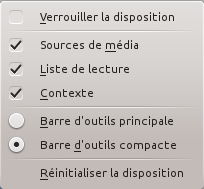Amarok/Manual/AmarokWindow/Toolbar/fr: Difference between revisions
(Created page with "La ''Barre d'outils'' est utilisée pour contrôler la lecture de la piste en train de jouer. Vous pouvez basculer de la barre d'outils principale à la barre d'outils compac...") |
(Created page with "La barre d'outils peut être déverrouillée et déplacée n'importe où sur vote écran, et même utilisée sans que le reste de la fenêtre d' '''Amarok''' ne soit affiché...") |
||
| Line 11: | Line 11: | ||
être cachée ; utilisez le raccourci <keycap>Ctrl + M</keycap> pour la cacher ou l'afficher à nouveau. | être cachée ; utilisez le raccourci <keycap>Ctrl + M</keycap> pour la cacher ou l'afficher à nouveau. | ||
La barre d'outils peut être déverrouillée et déplacée n'importe où sur vote | |||
écran, et même utilisée sans que le reste de la fenêtre d' '''Amarok''' ne soit affichée. Pour déverrouiller la barre d'outils, vous devez d'abord vous | |||
assurer que l'élément du menu <menuchoice>Vue -> Verrouiller la disposition</menuchoice> ne soit pas coché. Maintenant vous pouvez saisir la barre d'outils sur son | |||
côté gauche et la glisser-déposer n'importe où. Pour retourner à sa position | |||
initiale, glissez-déposez-la où elle était à l'origine tant que la | |||
disposition reste déverrouillée. | |||
<span id="Main Toolbar"></span> | <span id="Main Toolbar"></span> | ||
==== Barre d'outils principale ==== | ==== Barre d'outils principale ==== | ||
Revision as of 17:41, 19 January 2014
Barre d'outils
Introduction

La Barre d'outils est utilisée pour contrôler la lecture de la piste en train de jouer. Vous pouvez basculer de la barre d'outils principale à la barre d'outils compacte en utilisant le menu dans la Barre de menus. La barre de menu peut optionnellement être cachée ; utilisez le raccourci Ctrl + M pour la cacher ou l'afficher à nouveau.
La barre d'outils peut être déverrouillée et déplacée n'importe où sur vote écran, et même utilisée sans que le reste de la fenêtre d' Amarok ne soit affichée. Pour déverrouiller la barre d'outils, vous devez d'abord vous assurer que l'élément du menu ne soit pas coché. Maintenant vous pouvez saisir la barre d'outils sur son côté gauche et la glisser-déposer n'importe où. Pour retourner à sa position initiale, glissez-déposez-la où elle était à l'origine tant que la disposition reste déverrouillée.
Barre d'outils principale

This is the default Toolbar. It has a ![]() /
/ ![]() button on the left and displays the song title, album and artist in the center-top.
button on the left and displays the song title, album and artist in the center-top.
The previous and next track are shown on either side of the song title. Clicking one of them will make Amarok skip to that track.
A Progressbar with the already played time on the left and remaining time on the right shows the current position in the song. If you have Moodbars enabled, and .mood files for your tracks, this is where they will be displayed. More about the Moodbar later.
By using the slightly transparent ![]() and
and ![]() buttons next to the text you can add the current song to your loved tracks on last.fm or add a position marker.
buttons next to the text you can add the current song to your loved tracks on last.fm or add a position marker.
On the right is the volume-control button. A blue circle around the button shows the current volume. The volume is 0 at the bottom and increases clockwise. Change volume by clicking on the volume circle or by using the scroll wheel while the mouse hovers the button. The sound can also be completely muted by clicking on the speaker in the center.
Slim Toolbar

The Slim Toolbar has the same functionality as the Main Toolbar, but is more compact. Additionally the Slim Toolbar has a ![]() button to stop playing so the current song will be restarted when you press
button to stop playing so the current song will be restarted when you press ![]() again. All buttons concerning the current track are on the left and only the volume control on the right side. Here the volume is controlled by clicking on the button and dragging the slider or using the scroll wheel while the mouse is hovering the button.
again. All buttons concerning the current track are on the left and only the volume control on the right side. Here the volume is controlled by clicking on the button and dragging the slider or using the scroll wheel while the mouse is hovering the button.
